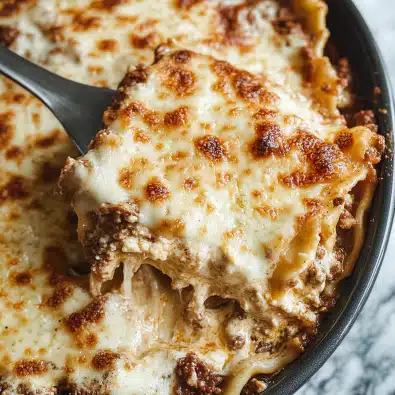Lasagna is a beloved dish that has transcended borders, but few can match the authenticity and richness of Classic Tuscan Lasagna. This traditional Italian recipe is not only hearty and comforting but also showcases the culinary prowess of Tuscany through its layers of robust ragù, creamy béchamel sauce, and generous portions of Parmigiano cheese. Whether you’re serving a family dinner or hosting friends, this Tuscan delight will surely impress. In this article, we’ll guide you through the preparation and cooking process to create a delicious lasagna that embodies the essence of Italian cuisine.

Ingredients
To get started on your culinary adventure, you will need the following ingredients:
- 3 lbs Tuscan Ragù (see notes)
- 1 package Lasagna sheets (about 4 portions of fresh pasta)
- 2 cups Parmigiano cheese, grated
For the Béchamel Sauce:
- 4 cups Milk
- ½ cup Butter
- ½ cup Flour
- Salt
- Black Pepper
- Nutmeg, ground
Instructions
1. Prepare the Béchamel Sauce
- In a pot, melt the butter and add the flour. Mix until you get a paste and cook it for a minute or two until it gets thicker.
- Gradually add the room temperature or warm milk while turning down the heat. Mix occasionally to melt the roux and ensure it doesn’t stick to the pot.
- Let the mixture simmer for 15-20 minutes until it thickens enough to coat a spoon. Season with salt, black pepper, and a pinch of ground nutmeg to taste.
2. Assemble the Layers
- Preheat your oven to 200°C (400°F).
- Spread a thin layer of the béchamel sauce on the bottom of the pan. Add a layer of lasagna sheets, followed by a layer of ragù sauce, a layer of béchamel sauce, and a sprinkling of grated Parmigiano cheese.
- Repeat the layers, pressing down slightly when adding the pasta. When the pan is full, finish with a final layer of pasta, sauce, and a generous amount of grated Parmigiano cheese.
- Bake on the middle rack of the oven for about 35-40 minutes. If the crust is not crunchy enough, finish with 3-4 minutes under the broiler. If the crust begins to brown too much before the cooking time is over, loosely cover the pan with foil.

Serving and Storage Tips
Serving Tips
- Let It Rest: Allow the lasagna to rest for about 10-15 minutes after baking. This helps the layers set, making it easier to slice and serve.
- Garnish: Add a sprinkle of fresh basil or parsley on top before serving for a pop of color and added freshness.
- Pairing: Serve your lasagna with a side salad dressed with a light vinaigrette, garlic bread, or a simple green vegetable for a well-rounded meal.
- Portion Sizes: Cut the lasagna into equal squares for serving to ensure everyone gets a fair share. Use a sharp knife for clean cuts.
- Wine Pairing: Pair your lasagna with a robust red wine, such as Chianti or Sangiovese, to complement the rich flavors of the dish.
Storage Tips
- Refrigeration: Store leftover lasagna in an airtight container in the refrigerator. It should be consumed within 3-5 days for the best quality.
- Freezing: If you want to store lasagna for a longer period, it can be frozen. Wrap individual portions tightly in plastic wrap, followed by aluminum foil, or place them in a freezer-safe container. It can be frozen for up to 2-3 months.
- Reheating: When ready to eat, thaw frozen lasagna in the refrigerator overnight. Reheat in the oven at 175°C (350°F) until heated through (about 20-30 minutes) or in the microwave until warm. If using the oven, cover with foil to prevent the top from burning.
- Avoid Overheating: To maintain the texture of the béchamel and pasta, avoid overheating the lasagna. A gentle reheat will ensure it remains creamy and delicious.
- Serving Size: Consider reheating only the amount you plan to eat to maintain the quality of the remaining portions.
By following these serving and storage tips, you can enjoy your Classic Tuscan Lasagna over several meals while preserving its rich flavors and textures. Enjoy!
variations
1. Vegetable Lasagna
Ingredients:
- Zucchini, sliced
- Spinach or Swiss chard
- Mushrooms, sliced
- Roasted red peppers
- Ricotta cheese (optional)
- Additional herbs (e.g., basil, oregano)
Details:
In this variation, substitute the meat-based Tuscan ragù with a medley of roasted or sautéed vegetables. Layer the vegetables with béchamel sauce, lasagna sheets, and Parmigiano cheese. You can also include ricotta cheese for added creaminess and richness. Season with fresh herbs for a vibrant flavor.
2. Spinach and Ricotta Lasagna
Ingredients:
- 2 cups fresh spinach (or thawed frozen spinach)
- 15 oz ricotta cheese
- 1 egg (optional, for binding)
- Nutmeg
- 1 cup marinara sauce (for a tangy layer)
Details:
Combine fresh spinach with ricotta cheese and a pinch of nutmeg to create a creamy filling. Spread a layer of marinara sauce in addition to the béchamel and ragù sauces for a flavorful twist. This variation is lighter and perfect for those who prefer a meatless option.
3. Pesto Chicken Lasagna
Ingredients:
- 2 cups shredded cooked chicken
- 1 cup basil pesto
- 1 cup mozzarella cheese, shredded
- Cherry tomatoes, halved
Details:
In this variation, mix shredded cooked chicken with basil pesto instead of using ragù. Layer the pesto chicken with béchamel sauce, lasagna sheets, and fresh mozzarella. Top with halved cherry tomatoes for a fresh touch. This adds a bright and herby flavor profile.
4. Mushroom and Truffle Lasagna
Ingredients:
- 2 cups mushrooms, sliced (shiitake, cremini, or button)
- Truffle oil or truffle salt
- 1 cup mascarpone cheese
Details:
Sauté mushrooms until golden and mix them with béchamel sauce and a drizzle of truffle oil or sprinkle of truffle salt. Layer the mushroom mixture with lasagna sheets and add dollops of mascarpone for extra creaminess. This variation elevates the dish with luxurious flavors.
5. Meat and Cheese Lasagna
Ingredients:
- 1 lb ground beef or Italian sausage
- 1 lb ground pork
- 2 cups mozzarella cheese, shredded
Details:
For a heartier version, combine ground beef and ground pork to create a rich and flavorful ragù. Layer with béchamel sauce, mozzarella, and Parmigiano cheese for an extra cheesy experience. This variation is a classic take that maximizes the savory meat flavor.
6. Seafood Lasagna
Ingredients:
- 1 lb shrimp, peeled and deveined
- 1 lb scallops
- 1 cup crab meat
- Lemon zest and juice
- White wine (optional)
Details:
Use a mix of shrimp, scallops, and crab meat for a luxurious seafood lasagna. Sauté the seafood with garlic and a splash of white wine, then layer with béchamel and lasagna sheets. Add lemon zest and juice for brightness. This coastal twist offers a fresh and elegant dish.
7. Mexican-Inspired Lasagna
Ingredients:
- 1 lb ground beef or turkey
- 1 can black beans
- 1 cup corn kernels
- 1 cup salsa
- 1 tsp taco seasoning
- 2 cups shredded cheese (cheddar or Mexican blend)
Details:
Combine ground meat with black beans, corn, salsa, and taco seasoning for a Mexican-inspired twist. Layer with béchamel or a white sauce seasoned with cumin and chili powder, along with shredded cheese. Top with fresh cilantro before serving for added flavor.
These variations on Classic Tuscan Lasagna allow you to explore new flavors and ingredients while maintaining the essence of this beloved dish. Whether you prefer meat, vegetables, or seafood, there’s a lasagna option to suit every palate. Enjoy experimenting with these ideas to create your own signature lasagna masterpiece!
FAQs
1. Can I use store-bought pasta instead of fresh lasagna sheets?
Yes, you can use store-bought lasagna noodles. Just be sure to follow the package instructions for cooking times. If using dry pasta, you may want to cook it slightly less than the recommended time since it will continue cooking in the oven.
2. What can I use instead of Tuscan ragù?
If you can’t find Tuscan ragù, you can use any good-quality marinara or meat sauce. You can also make your own by cooking ground meat with tomatoes, onions, garlic, and Italian herbs.
3. How can I make my lasagna less soggy?
To prevent sogginess, ensure that you drain excess moisture from your ragù and béchamel sauce before layering. Additionally, you can lightly bake the lasagna sheets for a few minutes before assembling or use a thicker béchamel.
4. Can I prepare lasagna in advance?
Yes! You can assemble the lasagna a day ahead and refrigerate it. Just add a few extra minutes to the baking time if baking from cold. Alternatively, you can freeze it before baking for up to three months.
5. How do I store leftover lasagna?
Store leftover lasagna in an airtight container in the refrigerator for 3-5 days. You can also freeze it for up to 2-3 months. To reheat, thaw in the refrigerator overnight and warm in the oven or microwave.
6. Can I make a vegetarian version of this lasagna?
Absolutely! Substitute the meat with roasted vegetables, spinach, or mushrooms, and add ricotta or other cheese for a delicious vegetarian alternative.
7. What is béchamel sauce, and why is it used in lasagna?
Béchamel sauce is a creamy white sauce made from butter, flour, and milk. It adds richness and creaminess to the lasagna, helping to balance the flavors of the ragù and cheese layers.
8. Can I use different cheeses?
Yes, while Parmigiano is traditional, you can mix in other cheeses like mozzarella, ricotta, or even a blend of Italian cheeses to customize the flavor and texture of your lasagna.
These FAQs should help clarify common questions and concerns when making Classic Tuscan Lasagna, ensuring you have a smooth cooking experience. Enjoy your culinary adventure!
Your Classic Tuscan Lasagna is now ready to be enjoyed! This dish not only offers a satisfying blend of flavors but also brings a piece of Tuscany to your table. With its layers of tender pasta, rich ragù, and creamy béchamel, it’s perfect for any occasion. Serve it with a fresh salad and a glass of Italian wine for a complete meal that will leave your guests raving. Enjoy the process of making this delicious lasagna, and don’t forget to share it with family and friends! Buon Appetito!
Print
Classic Tuscan Lasagna
Description
Lasagna is a beloved dish that has transcended borders, but few can match the authenticity and richness of Classic Tuscan Lasagna. This traditional Italian recipe is not only hearty and comforting but also showcases the culinary prowess of Tuscany through its layers of robust ragù, creamy béchamel sauce, and generous portions of Parmigiano cheese. Whether you’re serving a family dinner or hosting friends, this Tuscan delight will surely impress. In this article, we’ll guide you through the preparation and cooking process to create a delicious lasagna that embodies the essence of Italian cuisine.
Ingredients
- 3 lbs Tuscan Ragù (see notes)
- 1 package Lasagna sheets (about 4 portions of fresh pasta)
- 2 cups Parmigiano cheese, grated
For the Béchamel Sauce:
- 4 cups Milk
- ½ cup Butter
- ½ cup Flour
- Salt
- Black Pepper
- Nutmeg, ground
Instructions
1. Prepare the Béchamel Sauce
- In a pot, melt the butter and add the flour. Mix until you get a paste and cook it for a minute or two until it gets thicker.
- Gradually add the room temperature or warm milk while turning down the heat. Mix occasionally to melt the roux and ensure it doesn’t stick to the pot.
- Let the mixture simmer for 15-20 minutes until it thickens enough to coat a spoon. Season with salt, black pepper, and a pinch of ground nutmeg to taste.
2. Assemble the Layers
- Preheat your oven to 200°C (400°F).
- Spread a thin layer of the béchamel sauce on the bottom of the pan. Add a layer of lasagna sheets, followed by a layer of ragù sauce, a layer of béchamel sauce, and a sprinkling of grated Parmigiano cheese.
- Repeat the layers, pressing down slightly when adding the pasta. When the pan is full, finish with a final layer of pasta, sauce, and a generous amount of grated Parmigiano cheese.
- Bake on the middle rack of the oven for about 35-40 minutes. If the crust is not crunchy enough, finish with 3-4 minutes under the broiler. If the crust begins to brown too much before the cooking time is over, loosely cover the pan with foil.
Notes
Serving Tips
- Let It Rest: Allow the lasagna to rest for about 10-15 minutes after baking. This helps the layers set, making it easier to slice and serve.
- Garnish: Add a sprinkle of fresh basil or parsley on top before serving for a pop of color and added freshness.
- Pairing: Serve your lasagna with a side salad dressed with a light vinaigrette, garlic bread, or a simple green vegetable for a well-rounded meal.
- Portion Sizes: Cut the lasagna into equal squares for serving to ensure everyone gets a fair share. Use a sharp knife for clean cuts.
- Wine Pairing: Pair your lasagna with a robust red wine, such as Chianti or Sangiovese, to complement the rich flavors of the dish.
Storage Tips
- Refrigeration: Store leftover lasagna in an airtight container in the refrigerator. It should be consumed within 3-5 days for the best quality.
- Freezing: If you want to store lasagna for a longer period, it can be frozen. Wrap individual portions tightly in plastic wrap, followed by aluminum foil, or place them in a freezer-safe container. It can be frozen for up to 2-3 months.
- Reheating: When ready to eat, thaw frozen lasagna in the refrigerator overnight. Reheat in the oven at 175°C (350°F) until heated through (about 20-30 minutes) or in the microwave until warm. If using the oven, cover with foil to prevent the top from burning.
- Avoid Overheating: To maintain the texture of the béchamel and pasta, avoid overheating the lasagna. A gentle reheat will ensure it remains creamy and delicious.
- Serving Size: Consider reheating only the amount you plan to eat to maintain the quality of the remaining portions.
